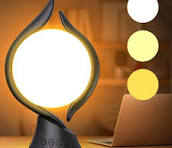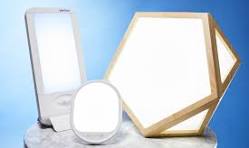
Have you ever noticed how your mood takes a nosedive during dark, gloomy months or when you spend too much time indoors?
That’s where light therapy lamps come in.
They’re like a burst of sunshine on a cloudy day.
But before you jump in, let me explain what these lamps are all about and why they matter.
Light therapy has roots in ancient times when people bask in the sun to heal various ailments.
Fast forward to today, and we have these nifty gadgets called light therapy lamps that mimic natural light.
Mood regulation and light are best friends.
Our brains crave sunlight, and our mood can tank when it’s in short supply.
Light therapy lamps fill that gap, helping lift spirits and brighten moods without stepping outside.
It’s not just the mood we’re talking about here.
These lamps also help treat conditions like Seasonal Affective Disorder (SAD), where a lack of sunlight leads to severe mood dips.
Imagine feeling more energetic and positive just by sitting near a lamp!
Technology has come a long way.
Modern light therapy lamps are designed to be safe, effective, and easy to use.
They’re a far cry from the old-school methods of sitting in the sun.
So, investing in one of these can be a game-changer for your mood and overall well-being.

Benefits of Light Therapy Lamps for Mood Enhancement
Scientists have been all over this, and studies show that light therapy works wonders for enhancing mood.
How does it work? Well, it has to do with your brain and body chemistry.
The light from these lamps can influence your circadian rhythms and increase serotonin levels.
Consider serotonin as your brain’s feel-good drug—more serotonin, better mood.
If you struggle with Seasonal Affective Disorder (SAD), light therapy lamps could be your new best friend.
In those dreary winter months, these lamps help fill the sunlight gap, reducing symptoms like fatigue, irritability, and mild depression.
But it’s not just for SAD sufferers.
Light therapy can boost general mood and fight off those unwanted blues.
Who’s not looking for a mental pick-me-up these days?
Even if you’re not dealing with severe mood disorders, light therapy offers a natural and easy way to lift your spirits.
It’s like adding a splash of sunshine to your day without leaving your home.
You can’t ignore the scientific backing here.
Plenty of studies and expert opinions support the efficiency of light therapy in mood enhancement.
From university research to real-life testimonials, much evidence shows that light therapy is more than just a gimmick.
It’s a proven method to help you feel better and brighter.
Feeling sceptical?
However, consider this: more mental health professionals recommend light therapy lamps as part of their treatment plans.
It’s becoming more common as a complementary approach to traditional treatments like medication and therapy.
Seriously, these lamps are getting rave reviews from both users and pros.
Choosing the Right Light Therapy Lamp

So, you’re ready to get a light therapy lamp, but the options can be overwhelming.
Let’s break down what you must consider to pick the perfect one.
- Light intensity. You’ll usually see this measured in lux. For mood enhancement, especially for tackling symptoms of SAD, you’ll want a lamp with at least 10,000 lux. Anything less might not give you the poke your brain needs.
- Color temperature. Daylight lamps usually have a cool white or blue light, mimicking natural daylight. This type of light is what you’re aiming for to get that serotonin boost. Some people might find blue light more comfortable, while others prefer the cool white. It’s all about personal preference.
- Size and design. Your lamp should fit into your daily routine without being a hassle. Portable, desktop models might be handy if you’re always on the move, but more oversized lamps might be better if you mostly use them at home or work.
- Safety. This is very important. Look for lamps that are UV-free to avoid potential skin issues. Make sure the lamp has passed safety certifications—you don’t want to mess with unverified devices. Check for electronic certifications like UL or RoHS compliance to ensure you’re getting a safe, quality product.
User reviews can give you real insight. People who’ve already tried the lamp can tell you the nitty-gritty details you won’t find on the packaging. Pay attention to what they say about ease of use, effectiveness, and any trouble they might’ve faced. Expert reviews are usually more technical but can be just as helpful.
Finally, remember that one size doesn’t fit all.
What works for someone else might not work for you.
Finding your perfect match might take a little trial and error, but once you do, the benefits are well worth it.

How to Use Light Therapy Lamps Effectively
Getting the hang of using a light therapy lamp can maximize its benefits and seamlessly fit into your life.
First and foremost, follow the manufacturer’s instructions. These are tailored to make your experience safe and effective.
Placement matters a lot.
For optimal results, place the lamp about 16 to 24 inches from your face, slightly off-center so you’re not staring directly into it. The light should also be angled downward, mimicking natural sunlight.
Timing is another key factor. Use the lamp in the morning, ideally as soon as you wake up. A 20 to 30-minute session is usually enough, but this can vary based on individual needs and the specific lamp you’re using.
Stick to a routine. Consistency amplifies the benefits of light therapy. Make it part of your morning ritual – maybe while having breakfast, reading, or checking emails. This way, you won’t forget, and it starts your day on a bright note.
Avoid overuse!!!! More is not always better. Excessive exposure can lead to headaches, eye strain, or agitation. If you experience any discomfort, cut back your session time or the intensity of the light.
Incorporating these lamps into your daily routine requires a bit of adjustment, but the payoff in improved mood and energy levels is worth it. Once you find what works best for you, it becomes second nature.
Potential Risks and Side Effects

While light therapy lamps can be incredibly beneficial, being aware of potential risks and side effects is essential.
These side effects are mild and can be easily managed for most people.
Common side effects include headaches, eye strain, and mild nausea.
If you experience any of these, it’s usually a sign that you’ve been using the lamp for too long, or it’s too close to your face.
Adjust the distance or reduce the session length to see if the symptoms improve.
People with certain conditions should exercise caution. Those with
- Bipolar disorder might experience mood swings triggered by light therapy.
- Eye conditions requiring photosensitizing medications, consult your healthcare provider before starting light therapy.
Always start slow. Begin with shorter sessions and gradually increase the duration as your body adapts.
This gradual approach helps minimize any initial discomfort and ensures you get the benefits without adverse effects.
It’s important to listen to your body
If you feel any persistent discomfort or new symptoms, it’s best to seek advice from a healthcare professional.
They can provide personalized guidance and help determine if light therapy is right for you.
Real-life cases of adverse reactions are relatively rare but worth noting.
Some people might experience insomnia if they use the lamp too late in the day.
Timing your sessions correctly can help prevent sleep disturbances.
If you have any concerns, professional advice is always a good step.
Please take advantage of light therapy to bring brightness into your daily life and environment.

